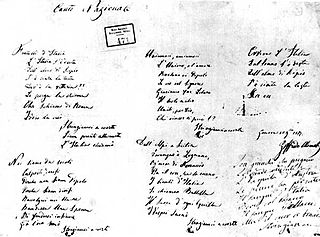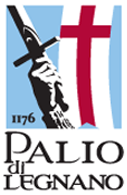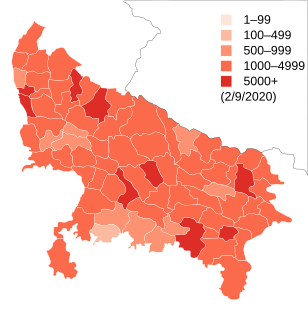
"Il Canto degli Italiani" is a canto written by Goffredo Mameli set to music by Michele Novaro in 1847, and is the current national anthem of Italy. It is best known among Italians as the Inno di Mameli, after the author of the lyrics, or Fratelli d'Italia, from its opening line. The piece, a 4/4 in B-flat major, consists of six strophes and a refrain that is sung at the end of each strophe. The sixth group of verses, which is almost never performed, recalls the text of the first strophe.
"Bella ciao" is an Italian protest folk song that originated in the late 19th century, sung by the mondina workers in protest to the harsh working conditions in the paddy fields of North Italy.

Palio is the name given in Italy to an annual athletic contest, very often of a historical character, pitting the neighbourhoods of a town or the hamlets of a comune against each other. Typically they are fought in costume and commemorate some event or tradition of the Middle Ages, and thus often involve horse racing, archery, jousting, crossbow shooting, and similar medieval sports. Once purely a matter of local rivalries, many have now become events staged with an eye to visitors and foreign tourists.

The Palio di Siena is a horse race that is held twice each year, on 2 July and 16 August, in Siena, Italy. Ten horses and riders, bareback and dressed in the appropriate colours, represent ten of the seventeen contrade, or city wards. The Palio held on 2 July is named Palio di Provenzano, in honour of the Madonna of Provenzano, a Marian devotion particular to Siena which developed around an icon from the Terzo Camollia area of the city. The Palio held on 16 August is named Palio dell'Assunta, in honour of the Assumption of Mary.
A contrada is a district, or a ward, within an Italian city. The most well-known contrade are probably the 17 contrade of Siena, whose representatives race on horseback in the Palio di Siena, run twice every year in July and August. Each is named after an animal or symbol, with a long history and complicated heraldic and semi-mythological associations.

The Corteo Storico is a historical costume parade in Siena, Tuscany, Italy. It takes place before the famous horse race known as the Palio on the 2nd of July and on August 16, each year.

The Palio di Legnano is a folk event generally held on the last Sunday of May in the City Of Legnano, Italy, to recall the Battle of Legnano held on 29 May 1176 by the Lombard League and the Holy Roman Empire of Frederick Barbarossa. This Palio is composed by a medieval pageant and a horse race. Until 2005 the whole event was named Sagra del Carroccio.

Roberto Speranza is an Italian politician of the Chamber of Deputies who serves as national secretary of Article One. Since 5 September 2019, he has been serving as Minister of Health in the government of Prime Minister Giuseppe Conte and was later confirmed by Prime Minister Mario Draghi. During his tenure, he had to face the COVID-19 pandemic, which deeply affected Italy.

The contrade of Legnano are the eight historical subdivisions into which the city of Legnano, in Lombardy, in Italy, is divided. They participate annually in the Palio di Legnano.

The COVID-19 pandemic in Italy is part of the pandemic of coronavirus disease 2019 caused by severe acute respiratory syndrome coronavirus 2. The virus was first confirmed to have spread to Italy on 31 January 2020, when two Chinese tourists in Rome tested positive for the virus. One week later an Italian man repatriated back to Italy from the city of Wuhan, China, was hospitalised and confirmed as the third case in Italy. Clusters of cases were later detected in Lombardy and Veneto on 21 February, with the first deaths on 22 February. By the beginning of March, the virus had spread to all regions of Italy.

Angelo Borrelli is an Italian government official, who served as Head of the Civil Protection, from 8 August 2017 until 26 February 2021.

On 9 March 2020, the government of Italy under Prime Minister Giuseppe Conte imposed a national lockdown or quarantine, restricting the movement of the population except for necessity, work, and health circumstances, in response to the growing pandemic of COVID-19 in the country. Additional lockdown restrictions mandated the temporary closure of non-essential shops and businesses. This followed a restriction announced on the previous day which affected sixteen million people in the whole region of Lombardy and in fourteen largely-neighbouring provinces in Emilia-Romagna, Veneto, Piedmont and Marche, and prior to that a smaller-scale lockdown of ten municipalities in the province of Lodi and one in the province of Padua that had begun in late February.

In response to the COVID-19 pandemic, national responses have been varied, and have included containment measures such as lockdowns, quarantines, and curfews. As of 13 April 2021, more than 137 million cases of COVID-19 have been reported in more than 192 countries and territories, resulting in more than 2.95 million deaths. More than 78.1 million people have recovered from the virus. The most affected countries in terms of confirmed cases are the United States, Brazil, India, Russia, South Africa, Peru, Mexico, Chile, the United Kingdom, and Iran.

The COVID-19 pandemic in Paraguay is part of the ongoing worldwide pandemic of coronavirus disease 2019 caused by severe acute respiratory syndrome coronavirus 2. The virus was confirmed to have reached Paraguay on March 7, 2020 in a 32-year-old man from Guayaquil, Ecuador, living in San Lorenzo, Central department.

The COVID-19 pandemic in Uttar Pradesh, India was first confirmed on 4 March 2020, with the first positive case in Ghaziabad. As of 4 December 2020, the state has 5,51,179 confirmed cases, resulting in 7,877 deaths and 5,20,637 recoveries. Case fatality rate in the state stands at 1.4%.
A stay-at-home order, safer-at-home order, movement control order, or lockdown restrictions – also referred to by loose use of the terms (self-) quarantine, (self-) isolation, or lockdown – is an order from a government authority that restricts movements of a population as a mass quarantine strategy for suppressing or mitigating an epidemic or pandemic by ordering residents to stay home except for essential tasks or for work in essential businesses. The medical distinction between such an order and a quarantine is that a quarantine is usually understood to involve isolating only selected people who are considered to be possibly infectious rather than the entire population of an area In many cases, outdoor activities are allowed. Non-essential businesses are either closed or adapted to working from home. In some regions, it has been implemented as a round-the-clock curfew or called a shelter-in-place order, but it is not to be confused with a shelter-in-place situation. Similar measures have been used around the world, and, both officially and colloquially, different names have been used to refer to them, often only very loosely linked to the term's actual medical meaning. Examples include confinement, (self-) isolation, (self-) quarantine, lockdown or ‘strict social distancing measures’. Stay-at-home orders have colloquially been referred to as quarantine or lockdown - but some officials have a concern that the word lockdown may send a wrong message for people to incorrectly think that it includes door-to-door searching for infected people to be forced into quarantines similar to the Hubei lockdown.

Due to the COVID-19 pandemic, a number of non-pharmaceutical interventions including lockdowns, stay-at-home orders, curfews, quarantines, cordons sanitaires and similar restrictions have been implemented in numerous countries and territories around the world. These restrictions were established to reduce the spread of the severe acute respiratory syndrome coronavirus 2 (SARS-CoV-2), which causes COVID-19. By April 2020, about half of the world's population was under lockdown, with more than 3.9 billion people in more than 90 countries or territories having been asked or ordered to stay at home by their governments.
"Quarantine" is a song recorded by American rock band Blink-182. The song was released on August 7, 2020, through Columbia Records. The fast-paced punk number explores boredom during the self-imposed lockdown caused by the COVID-19 pandemic. It was written by bassist Mark Hoppus, who sings solo vocals on the track. Additional songwriting is credited to drummer Travis Barker and songwriter Brian Lee, both of whom also produced the song.

The following is a timeline of the COVID-19 pandemic in Italy.

The "Marcia del Palio", commonly also called Squilli la fe', is an ancient hymn that accompanies the historical costume parade called Corteo Storico that precedes the Palio of Siena.
















